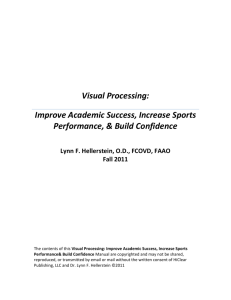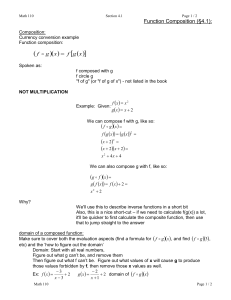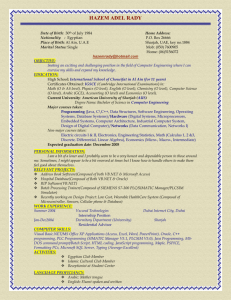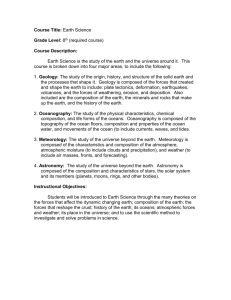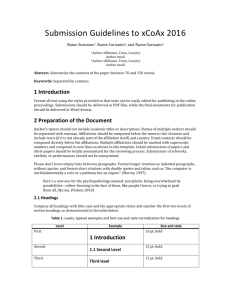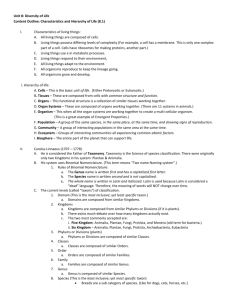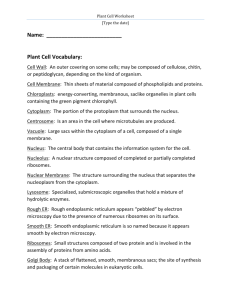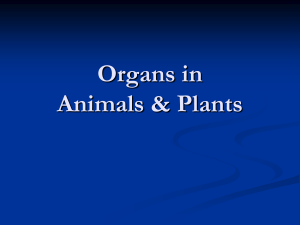M4 - Composing Systems v2
advertisement
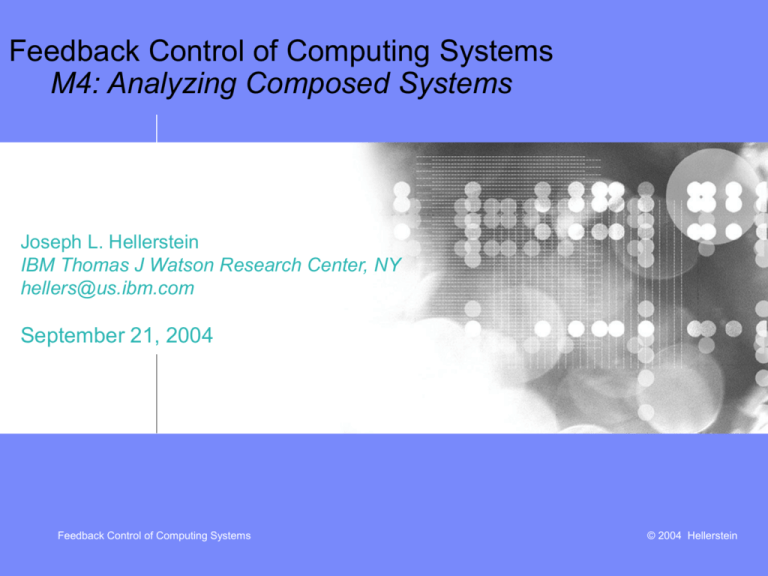
Feedback Control of Computing Systems
M4: Analyzing Composed Systems
Joseph L. Hellerstein
IBM Thomas J Watson Research Center, NY
hellers@us.ibm.com
September 21, 2004
Feedback Control of Computing Systems
© 2004 Hellerstein
Key Results for LTI Systems
U(z)
G(z)
Y(z)
Adding signals:
If {a(k)} and {b(k)} are signals, then
{c(k)=a(k)+b(k)} has Z-Transform
A(z)+B(z).
0.5
2
A(z)
+
0.4
C(z)
1.5
y(k)
+
u(k)
0.3
1
B(z)
0.2
0.5
0.1
0
0 10 20 30
k
0
0 10 20 30
k
Stable if |a|<1, where a is the largest pole of G(z)
kS
4
, where | a | is the largest pole of G(z)
log | a |
Transfer functions in series
U(z)
G(z)
H(z)
Y(z)
is equivalent to
U(z)
y ( )
G (1)
ssg of G(z) is
u ( )
2
W(z)
Feedback Control of Computing Systems: M4 - Composed Systems
G(z)H(z)
Y(z)
© 2004 Hellerstein
Motivating Example
r (k )
u(k + 1) u(k ) + K I e(k + 1)
+
e( k )
Controller
w(k + 1) (0.43) w(k ) + (0.47)u ( k )
u (k )
Notes
Server
y (k + 1) 0.8 y (k ) + 0.72w(k ) 0.66 w(k 1)
w( k )
Notes
Sensor
y (k )
e( k ) r ( k ) y ( k )
The problem
Want to find y(k) in terms of KI so can design control system that is stable, accurate,
settles quickly, and has small overshoot.
But this is difficult to do with ARX models.
The Solution
Use a different representation
This module addresses the analysis of composed systems: steady state gain, stability, settling time
3
Feedback Control of Computing Systems: M4 - Composed Systems
© 2004 Hellerstein
M4:
Lecture
4
Feedback Control of Computing Systems: M4 - Composed Systems
© 2004 Hellerstein
Outline
Canonical feedback loop and its transfer functions
Generalized canonical feedback loop
Complex structures
Reference: “Feedback Control of Computer Systems”, Chapter 4.
5
Feedback Control of Computing Systems: M4 - Composed Systems
© 2004 Hellerstein
Block Diagram Basics
D(z)
Controller
R(z)
U(z)
E(z)
+
K(z)
W(z)
+
Target System
+ V(z)
G(z)
H(z)
Transducer
6
Y(z)
Functional block: component of the system
Arrow: signal
Summation point: addition of signals
Branching point: signal with multiple destinations
Feedback Control of Computing Systems: M4 - Composed Systems
Permitted operations
Summing signals
Cascading systems
© 2004 Hellerstein
Canonical Feedback Loop
Disturbance
D(z) Input
Reference
Input
R(z)
Controller
U(z)
E(z)
+
K(z)
W(z)
+
Noise
Input
N(z)
Target System
Y(z) +
+ V(z)
G(z)
+
Measured
Output
T(z)
H(z)
Transducer
Want to analyze characteristics of the entire system, like its stability, settling time,
and accuracy (ability to achieve the reference input).
It’s all done with transfer functions!
7
Feedback Control of Computing Systems: M4 - Composed Systems
© 2004 Hellerstein
Canonical Feedback Loop – Reference Input
FR(z)
Reference
Input
R(z)
D(z)=0
Controller
U(z)
E(z)
+
K(z)
+
N(z)=0
Target System
Y(z) +
+ V(z)
G(z)
+
Measured
Output
T(z)
Transducer
W(z)
H(z)
View the dark rectangle as a large transfer function FR(z) with input R(z) and output
T(z).
System is stable if largest pole of FR(z) has an absolute value that is less than 1
System is accurate if FR(1)=1
System’s settling time is determined by the largest pole of FR(z)
8
Feedback Control of Computing Systems: M4 - Composed Systems
© 2004 Hellerstein
Canonical Feedback Loop Has Many T.F.
Disturbance
D(z) Input
Reference
Input
R(z)
U(z)
E(z)
K(z)
N(z)
Target System
Y(z) +
+ V(z)
G(z)
+
Controller
+
Noise
Input
+
W(z)
Measured
Output
T(z)
H(z)
A transfer function is specified in terms of its input and output.
Transducer
Assess
Assess
Accuracy
9
disturbance
robustness
FR (z)
FD (z )
Transfer function from the
reference input to the
measured output
Transfer function from the
disturbance input to the
measured output
FN (z )
Assess
noise
robustnes
s
Transfer function from the
noise input to the
measured output
Feedback Control of Computing Systems: M4 - Composed Systems
© 2004 Hellerstein
Results Used to Find T.F.
Adding signals:
If {a(k)} and {b(k)} are signals, then
{c(k)=a(k)+b(k)} has Z-Transform
A(z)+B(z).
A(z)
+
C(z)
+
B(z)
Transfer functions in series
U(z)
G(z)
W(z)
H(z)
Y(z)
is equivalent to
U(z)
10
Feedback Control of Computing Systems: M4 - Composed Systems
G(z)H(z)
Y(z)
© 2004 Hellerstein
Computing FR(z)
R(z)
Simplified B.D.
since
D(z)=0=N(z)
The only non-zero input is R(z).
U(z)
E(z)
+
T(z)
G(z)
K(z)
W(z)
H(z)
A set of equations relates R(z) to T(z) based on our previous results
W(z) = H(z)T(z) by the definition of a transfer function.
E(z) = R(z)-W(z) since this is an addition of signals.
T(z) = E(z)K(z)G(z) since K(z) and G(z) are in series.
T(z) = (R(z)-H(z)T(z))K(z)G(z) by substitution.
11
FR ( z )
T ( z)
K ( z )G ( z )
R( z ) 1 + K ( z )G ( z ) H ( z )
Feedback Control of Computing Systems: M4 - Composed Systems
© 2004 Hellerstein
Computing FD(z)=T(z)/D(z)
The only non-zero input is D(z).
N(z)=0
D(z)
R(z)=0
+
K(z)
G(z)
+
W(z)
W(z) = H(z)T(z) by the definition of a transfer function.
E(z) = -W(z) since this is an addition of signals.
T(z) = E(z)K(z)G(z) + D(z)G(z).
Y(z) = (-H(z)T(z))K(z)G(z) + D(z)G(z) by substitution.
12
Y(z) +
+ V(z)
U(z)
E(z)
T(z)
+
H(z)
FD ( z )
Feedback Control of Computing Systems: M4 - Composed Systems
G( z )
1 + K ( z )G( z ) H ( z )
© 2004 Hellerstein
Results Used Next
U(z)
G(z)
Y(z)
0.5
2
0.4
1.5
y(k)
u(k)
0.3
1
0.2
0.5
0.1
0
0 10 20 30
k
0
0 10 20 30
k
Stable if |a|<1, where a is the largest pole of G(z)
kS
4
, where | a | is the largest pole of G(z)
log | a |
y ( )
G (1)
ssg of G(z) is
u ( )
13
Feedback Control of Computing Systems: M4 - Composed Systems
© 2004 Hellerstein
Properties of Canonical Loop
R(z)
+
K(z)
FR ( z )
G(z)
+
W(z)
Reference to Output
FD ( z )
T(z)
+
H(z)
Disturbance to Output
T ( z)
K ( z )G ( z )
R( z ) 1 + K ( z )G ( z ) H ( z )
Y(z) +
+ V(z)
U(z)
E(z)
N(z)
D(z)
Noise to Output?
T ( z)
G( z )
D( z ) 1 + K ( z )G ( z ) H ( z )
FN ( z )
T ( z)
1
N ( z ) 1 + K ( z )G( z ) H ( z )
What can we say about the stability and settling times of these three transfer functions?
They are the same!
When is the system accurate in the sense that T(z)=R(z)? FR(1)=1
When is the system robust to disturbances and noise?
14
FD(1)=0= FN(1)
Feedback Control of Computing Systems: M4 - Composed Systems
© 2004 Hellerstein
Predicting Measured Outputs
R(z)
+
K(z)
Y(z) +
+ V(z)
U(z)
E(z)
N(z)
D(z)
G(z)
+
W(z)
T(z)
+
H(z)
What is T(z) if R(z), D(z), and N(z) are all non-zero?
T ( z ) R( z ) FR ( z ) + D( z ) FD ( z ) + N ( z ) FN ( z )
15
Feedback Control of Computing Systems: M4 - Composed Systems
© 2004 Hellerstein
Generalized Canonical Feedback Loop
I2(z)
I1(z)
In-1(z)
In+1(z)
+
+
G1(z)
Gn(z)
+
Hm(z)
What is F j ( z )
T(z)
+
H1(z)
T ( z)
?
I j ( z)
G j ( z )...Gn ( z )
T ( z)
Fj ( z)
I j ( z ) 1 + H1 ( z )...H m ( z )G j ( z )...Gn ( z )
16
Feedback Control of Computing Systems: M4 - Composed Systems
© 2004 Hellerstein
Nested Structures
R(z)
+
K1(z)
+
T(z)
K2(z)
G(z)
Find:
T ( z)
FR ( z )
R( z )
H(z)
is equivalent to
Approach 1: Solve directly.
R(z)
Approach 2:
a. Transform into a
canonical control
loop.
b. Apply result for
T.F. of canonical
control loop.
17
T(z)
+
K(z)
K 2 ( z )G ( z )
1 + K 2 ( z )G ( z )
H(z)
Feedback Control of Computing Systems: M4 - Composed Systems
© 2004 Hellerstein
Summary
Control systems have many transfer functions of interest
Key properties of system are indicated by the transfer functions
Stability, accuracy, settling time, robustness to disturbance, robustness to noise
Find transfer functions by
18
FR(z) – From reference input to measured output
FD(z) – From distrubance input to measured output
FN(z) – From noise input to measured output
Solving a (simple) set of equations
Transforming into a canonical control loop and solving
Feedback Control of Computing Systems: M4 - Composed Systems
© 2004 Hellerstein
Key Results for LTI Systems
U(z)
G(z)
Y(z)
Adding signals:
If {a(k)} and {b(k)} are signals, then
{c(k)=a(k)+b(k)} has Z-Transform
A(z)+B(z).
0.5
2
A(z)
+
0.4
C(z)
1.5
y(k)
+
u(k)
0.3
1
B(z)
0.2
0.5
0.1
Transfer functions in series
U(z)
0
0 10 20 30
k
G(z)
0
0 10 20 30
k
W(z)
H(z)
Y(z)
is equivalent to
Stable if |a|<1, where a is the largest pole of G(z)
kS
4
, where | a | is the largest pole of G(z)
log | a |
y ( )
G (1)
ssg of G(z) is
u ( )
19
U(z)
FR ( z )
G(z)H(z)
Y(z)
T ( z)
K ( z )G ( z )
R( z ) 1 + H ( z ) K ( z )G ( z )
Feedback Control of Computing Systems: M4 - Composed Systems
© 2004 Hellerstein
M4:
Labs
20
Feedback Control of Computing Systems: M4 - Composed Systems
© 2004 Hellerstein
Analytic Solution to First Lab Exercise
Block Diagram
Reference
RIS
+
r*
MaxUsers
e(k)
u(k)
Controller
Notes
Server
ARX Models
Actual
RIS
y(k)
Control error: e(k)=r*-y(k)
P controller: u(k)=Ke(k)
System model: y(k)=(0.43)y(k-1)
+(0.47)u(k-1)
Assignment
1. Find FR(z)
2. Find the steady state error K, K = .1, 1, 3
3. Find the poles for these same values of K. For each, determine the settling times.
How do they compare with simulation results?
21
Feedback Control of Computing Systems: M4 - Composed Systems
© 2004 Hellerstein
Solution
FR ( z )
T ( z)
K ( z )G( z )
R( z ) 1 + H ( z ) K ( z )G( z )
ARX Models
Control error: e(k)=r*-y(k)
P controller: u(k)=Ke(k)
System model: y(k)=(0.43)y(k-1)+(0.47)u(k-1)
e(k)
r*
+
Controller
Notes
u(k) Server
y(k)
U ( z)
K
E( z)
Y ( z)
0.47
G( z)
U ( z ) z 0.43
H ( z) 1
0.47
K
0.47 K
z 0.43
FR ( z )
0.47
z 0.43 + 0.47 K
1+ K
z 0.43
K ( z)
Compare with simulations in M1.
22
Feedback Control of Computing Systems: M4 - Composed Systems
© 2004 Hellerstein
Homework: Due 9/23/2004
D(z)
w(k+1)=0.43w(k)+0.47v(k)
y (k + 1) 0.8 y (k ) + 0.72w(k ) 0.66 w(k 1)
u(k)=u(k-1)+KIe(k)
+ V(z)
e( k )
Controller
u (k )
+
Notes
Server
w( k )
Notes
Sensor
y (k )
e( k ) r ( k ) y ( k )
Assignment
1. Find FD(z)
2. Assess the robustness of this control system to noise.
3. Use FD(z) to find the KI that produces the smallest settling time. (Hint: plot the largest
pole versus KI.
4. Verify the results of analysis using simulations.
23
Feedback Control of Computing Systems: M4 - Composed Systems
© 2004 Hellerstein
